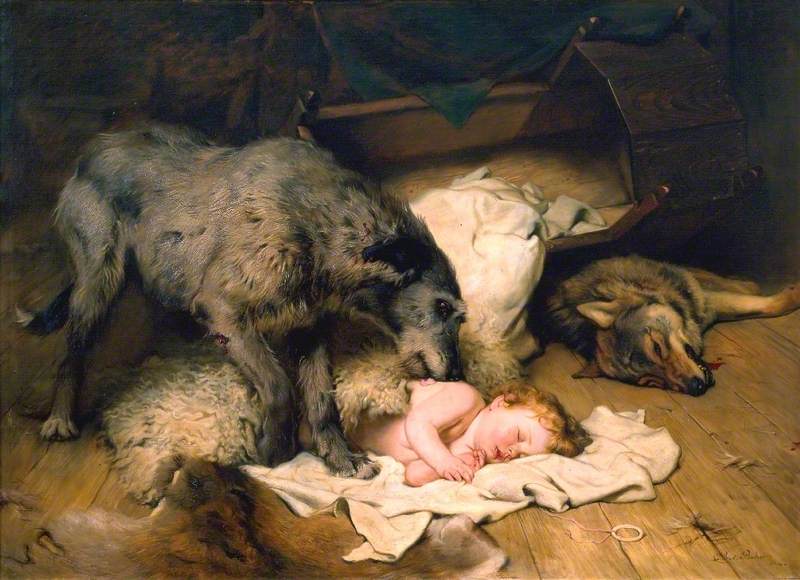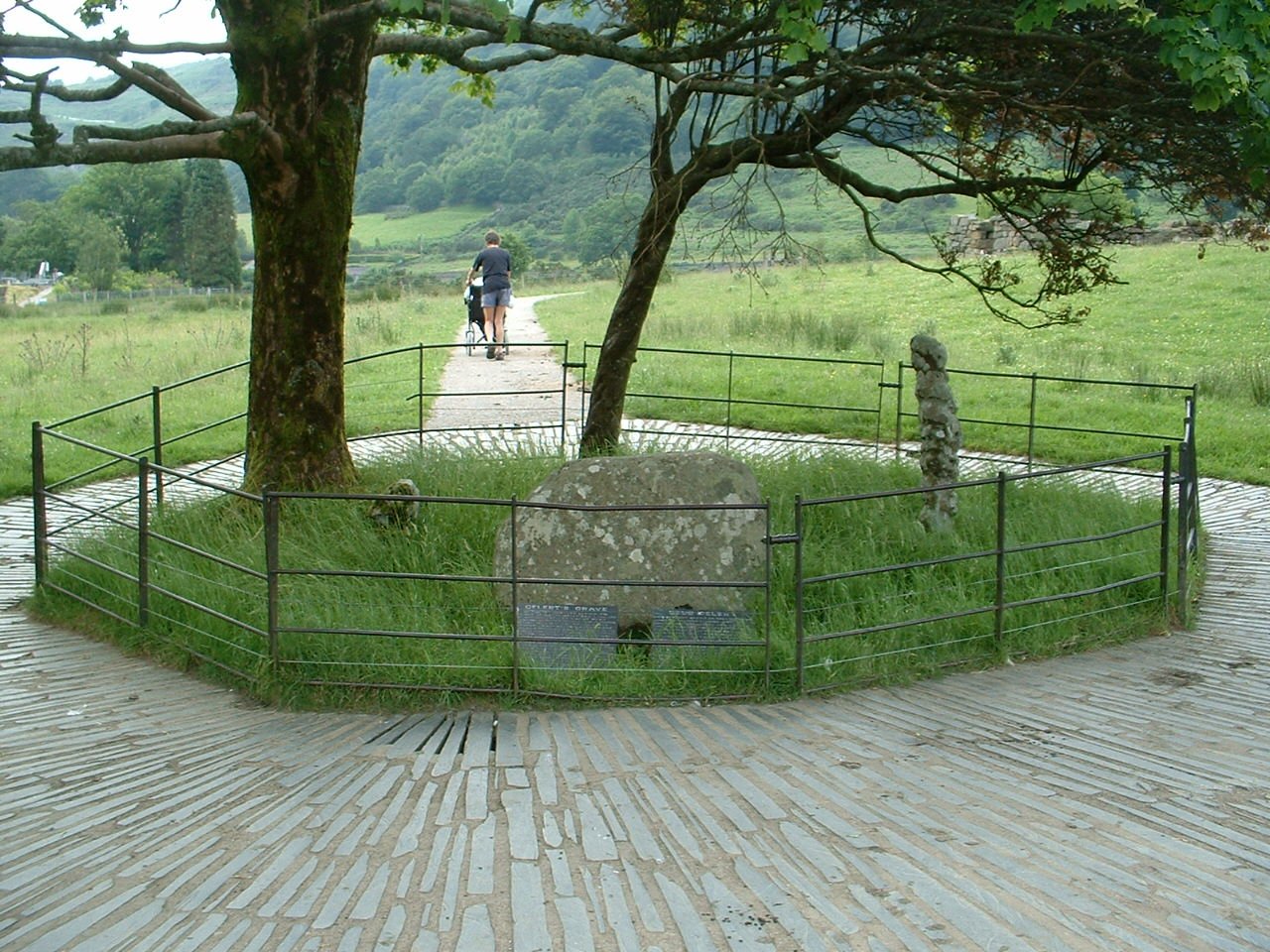Gelert (other) on:
[Wikipedia]
[Google]
[Amazon]
 Gelert () is a legendary wolfhound associated with the village of Beddgelert (whose name means "Gelert's Grave") in
Gelert () is a legendary wolfhound associated with the village of Beddgelert (whose name means "Gelert's Grave") in
 This story formed the basis for several English poems, among which are "Beth Gêlert; or, the Grave of the Greyhound" by
This story formed the basis for several English poems, among which are "Beth Gêlert; or, the Grave of the Greyhound" by

 It is now accepted that the village of Beddgelert took its name from an early saint named Kilart or Celert, rather than from the dog. The "grave" mound is ascribed to David Prichard, landlord of the Goat Hotel in Beddgelert in the late eighteenth century, who connected the legend to the village to encourage tourism.
On the supposed grave of Gelert there are two slate memorials, one in Welsh and the other in English. The latter reads:
It is now accepted that the village of Beddgelert took its name from an early saint named Kilart or Celert, rather than from the dog. The "grave" mound is ascribed to David Prichard, landlord of the Goat Hotel in Beddgelert in the late eighteenth century, who connected the legend to the village to encourage tourism.
On the supposed grave of Gelert there are two slate memorials, one in Welsh and the other in English. The latter reads:
Borrow's ''Wild Wales Chapter XLVI'': "The Valley of Gelert"
*[https://archive.today/20121215061002/http://etext.virginia.edu/etcbin/toccer-new2?id=FisMyth.sgm&images=images/modeng&data=/texts/english/modeng/parsed&tag=public&part=1&division=div1%23n1.3 John Fiske's ''Myths and Myth-makers: Old Tales and Superstitions Interpreted by Comparative Mythology Chapter 1:'' "The Origins of Folk-Lore."]
85
Poem Welsh folklore Dog monuments Individual dogs Mythological dogs Medieval legends Individual animals in Wales
 Gelert () is a legendary wolfhound associated with the village of Beddgelert (whose name means "Gelert's Grave") in
Gelert () is a legendary wolfhound associated with the village of Beddgelert (whose name means "Gelert's Grave") in Gwynedd
Gwynedd (; ) is a county and preserved county (latter with differing boundaries; includes the Isle of Anglesey) in the north-west of Wales. It shares borders with Powys, Conwy County Borough, Denbighshire, Anglesey over the Menai Strait, and C ...
, north-west Wales. In the legend, Llywelyn the Great
Llywelyn the Great ( cy, Llywelyn Fawr, ; full name Llywelyn mab Iorwerth; c. 117311 April 1240) was a King of Gwynedd in north Wales and eventually " Prince of the Welsh" (in 1228) and "Prince of Wales" (in 1240). By a combination of war and d ...
returns from hunting to find his baby missing, the cradle overturned, and Gelert with a blood-smeared mouth. Believing the dog had devoured the child, Llywelyn draws his sword and kills Gelert. After the dog's dying yelp, Llywelyn hears the cries of the baby, unharmed under the cradle, along with a dead wolf which had attacked the child and been killed by Gelert. Llywelyn is overcome with remorse and buries the dog with great ceremony, (then leading to the town name) but can still hear its dying yelp. After that day, Llywelyn never smiles again.
The story is a variation on the '' "Faithful Hound" folk-tale motif'', which lives on as an urban legend. It is classified as Aarne–Thompson type 178A.
Poems and other interpretations
 This story formed the basis for several English poems, among which are "Beth Gêlert; or, the Grave of the Greyhound" by
This story formed the basis for several English poems, among which are "Beth Gêlert; or, the Grave of the Greyhound" by William Robert Spencer
William Robert Spencer (9 January 176922/23 October 1834) was an English poet and wit from the Spencer family.
Life
He was the younger son of Lord Charles Spencer and his wife Mary Beauclerk. He was the grandson of Charles Spencer, 3rd Duke of M ...
written around 1800; "Beth Gelert" by Richard Henry Horne; "Gelert" by Francis Orray Ticknor and the dramatic poem "Llewellyn" by Walter Richard Cassels. The tale is also alluded to by John Critchley Prince
John Critchley Prince (1808–1866) was an English labouring-class poet. His ''Hours of the Muses'' went through six editions.
Life
Born at Wigan, Lancashire, on 21 June 1808, Prince was the son of a poor reed-maker for weavers. He learned to read ...
in lines 24 to 29 of his poem "North Wales:" "Thou hast not trod with pilgrim foot the ground / Where sleeps the canine martyr of distrust, / Poor Gelert, famed in song, as brave a hound / As ever guarded homestead, hut, or hall, / Or leapt exulting at the hunter’s call; / As ever grateful man consigned to dust." Despite this, and despite the presence of a raised mound in the village called Gelert's Grave, historians do not believe that Gelert ever existed.
It is recorded in '' Wild Wales'' (1862) by George Borrow, who notes it as a well known legend; by '' Brewer's Dictionary of Phrase and Fable'', which details versions of the same story from other cultures; and by '' The Nuttall Encyclopaedia'', under the Anglicised spellings "Gellert" and "Killhart". John Fiske discusses Gelert in his ''Myths and Myth-makers'', saying regretfully that "as the Swiss must give up his Tell, so must the Welshman be deprived of his brave dog Gellert, over whose cruel fate I confess to having shed more tears than I should regard as well bestowed upon the misfortunes of many a human hero of romance." He notes that "to this day the visitor to Snowdon is told the touching story, and shown the place, called Beth-Gellert, where the dog's grave is still to be seen. Nevertheless, the story occurs in the fireside lore of nearly every Aryan
Aryan or Arya (, Indo-Iranian *''arya'') is a term originally used as an ethnocultural self-designation by Indo-Iranians in ancient times, in contrast to the nearby outsiders known as 'non-Aryan' (*''an-arya''). In Ancient India, the term ' ...
people."
The tale indeed appears in numerous cultures with minor variations. The Alpine ligurian poem ''R sacrifisi dr can'', written in Ligurian, tells of how a shepherd shot his sheepdog after finding it covered in sheep blood, only to later find a dead wolf in the stable.
In India, a black snake replaces the wolf and a mongoose replaces the dog. In Egypt, the story goes that a cook nearly killed a Wali for having smashed a pot of herbs, but later discovers that the pot contained a poisonous snake.
In Malaysian folklore, a similar story involves a tame bear
Bears are carnivoran mammals of the family Ursidae. They are classified as caniforms, or doglike carnivorans. Although only eight species of bears are extant, they are widespread, appearing in a wide variety of habitats throughout the Nor ...
, kept by a Malay hunter as the guardian of his young daughter. As in the story of Gelert, the hunter returns home from an expedition, and finds his daughter gone and the bear covered in blood. Hastily thinking the bear has devoured his daughter, the hunter kills it with his spear, but later finds the body of a tiger, killed by the bear in defence of the hunter's daughter, who shortly emerges from the jungle, from where she took refuge.
In the Disney movie '' Lady and the Tramp'' (1955), Tramp is carried off to the pound after Aunt Sarah finds him in a nursery with the cradle overturned. In this version of the tale, the "Gelert" figure is rescued: Lady manages to show "Jim Dear" the dead rat hidden behind a curtain, and the parents realize that Tramp actually saved their child from the rat.
In 2002 the '' Incredible Story Studios'' made a short film called "The Return of Gelert", written by a Welsh schoolchild, which depicts the ghost of Gelert returning to haunt early 21st century Beddgelert.
Gelert's grave

 It is now accepted that the village of Beddgelert took its name from an early saint named Kilart or Celert, rather than from the dog. The "grave" mound is ascribed to David Prichard, landlord of the Goat Hotel in Beddgelert in the late eighteenth century, who connected the legend to the village to encourage tourism.
On the supposed grave of Gelert there are two slate memorials, one in Welsh and the other in English. The latter reads:
It is now accepted that the village of Beddgelert took its name from an early saint named Kilart or Celert, rather than from the dog. The "grave" mound is ascribed to David Prichard, landlord of the Goat Hotel in Beddgelert in the late eighteenth century, who connected the legend to the village to encourage tourism.
On the supposed grave of Gelert there are two slate memorials, one in Welsh and the other in English. The latter reads:
IN THE 13TH CENTURY, LLYWELYN, PRINCE OF NORTH WALES, HAD A PALACE AT BEDDGELERT. ONE DAY HE WENT HUNTING WITHOUT GELERT "THE FAITHFUL HOUND" WHO WAS UNACCOUNTABLY ABSENT. ON LLYWELYN'S RETURN, THE TRUANT STAINED AND SMEARED WITH BLOOD, JOYFULLY SPRANG TO MEET HIS MASTER. THE PRINCE ALARMED HASTENED TO FIND HIS SON, AND SAW THE INFANT'S COT EMPTY, THE BEDCLOTHES AND FLOOR COVERED WITH BLOOD. THE FRANTIC FATHER PLUNGED THE SWORD INTO THE HOUND'S SIDE THINKING IT HAD KILLED HIS HEIR. THE DOG'S DYING YELL WAS ANSWERED BY A CHILD'S CRY. LLYWELYN SEARCHED AND DISCOVERED HIS BOY UNHARMED BUT NEAR BY LAY THE BODY OF A MIGHTY WOLF WHICH GELERT HAD SLAIN, THE PRINCE FILLED WITH REMORSE IS SAID NEVER TO HAVE SMILED AGAIN. HE BURIED GELERT HERE. THE SPOT IS CALLED BEDDGELERT.
See also
* Jock of the Bushveld * Saint Gelert * Saint Guinefort * List of individual dogsReferences
Borrow's ''Wild Wales Chapter XLVI'': "The Valley of Gelert"
*[https://archive.today/20121215061002/http://etext.virginia.edu/etcbin/toccer-new2?id=FisMyth.sgm&images=images/modeng&data=/texts/english/modeng/parsed&tag=public&part=1&division=div1%23n1.3 John Fiske's ''Myths and Myth-makers: Old Tales and Superstitions Interpreted by Comparative Mythology Chapter 1:'' "The Origins of Folk-Lore."]
Further reading
* Dramatic poem * * Poem * Poem * {{cite book , url=https://archive.org/details/poemsfrancisorr00tickgoog , quote=Francis Orray Ticknor gelert. , chapter=Gelert , title=The poems of Francis Orray Ticknor , first1=Francis Orray , last1=Ticknor , place=New York & Washington , publisher=The Neale Publishing Co , year=1911 , pag85
Poem Welsh folklore Dog monuments Individual dogs Mythological dogs Medieval legends Individual animals in Wales